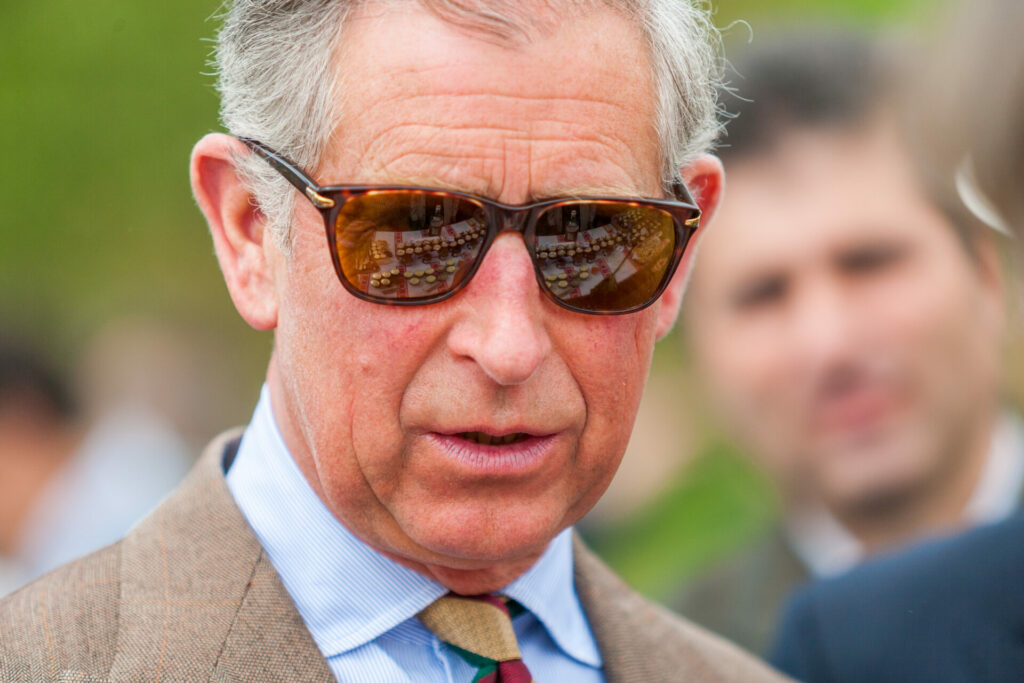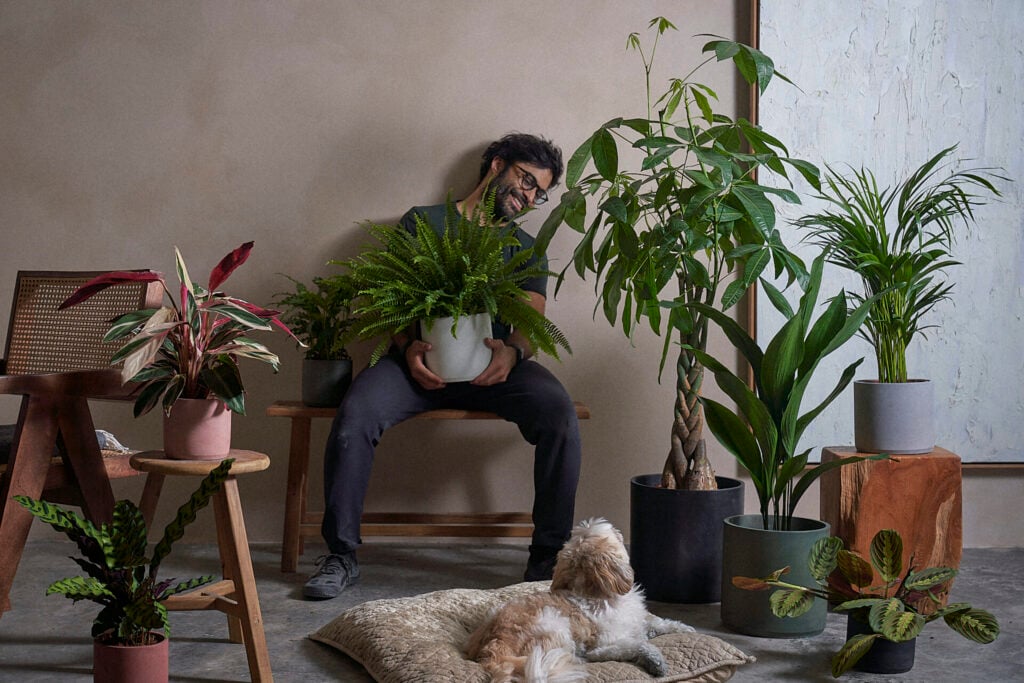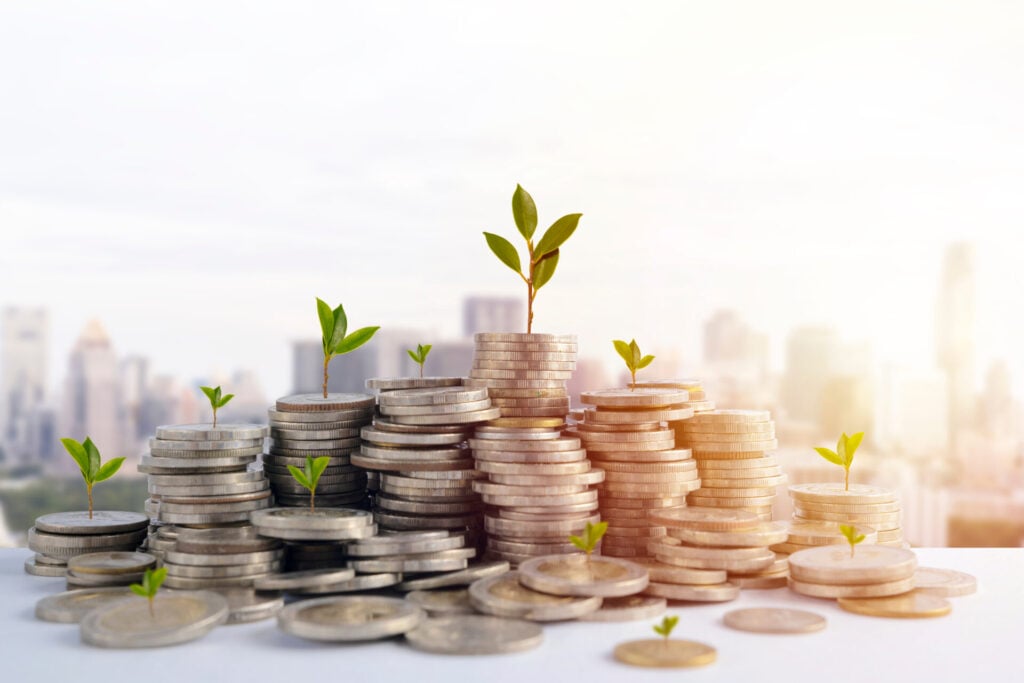A gloveless vendor fillets a wriggling eel on a countertop already streaked with blood as motionless caged tortoises are stacked beneath live rabbits just metres away. Even though Singapore is one of the world’s most heavily regulated countries, this was the everyday scene in one of its bustling Chinatown wildlife markets witnessed on a visit in February 2020 before most of us had ever uttered the words ‘pandemic’ or ‘zoonotic disease’.
Three thousand miles away in Eastern China, Huanan Seafood Wholesale Market in Wuhan, the presumed early epicentre of the Covid-19 outbreak, had already been shuttered for a month. Despite the name, it wasn’t just seafood but endangered pangolins, along with snakes and beavers, on sale to eat in its ‘wild animal’ section.
As well as being inhumane, this mixing of different species in close quarters is a breeding ground for the transmission of deadly diseases from animal-to-animal and animal-to-human. ‘The blood, excrement and other bodily fluids can easily get on sellers’ and customers’ shoes and be tracked into people’s homes,’ Amruta Ubale, Animal Equality’s Executive Director in India, tells The Ethicalist.

A crisis of our own making, as well as being a worldwide wake-up call to humanity, the Covid-19 pandemic put the global wildlife trade firmly in the spotlight, since many of the markets’ caged animals are also illegally trafficked and endangered.
But how much has changed? With a worrying surge in ‘walking pneumonia’ – a persistent respiratory infection – across America and a recent deadly monkeypox outbreak in Central Africa, The Ethicalist asks: is history about to repeat itself in the post-Covid era?
In Huahan Market, Yelp listed a single stall selling 100 species including live peacocks and civets: a racoon-faced mammal that’s also a Chinese delicacy served up in a pricey soup
According to the World Health Organisation (WHO), 75 per cent of emerging infectious diseases spread to humans originate in animals. In Huahan Market, Yelp listed a single stall selling 100 species including live peacocks and civets: a racoon-faced mammal that’s also a Chinese delicacy served up in a pricey soup. WHO claims a civet was to blame for China’s 2002 outbreak of SARS which killed 800 people. An ‘intermediate host animal’, it was likely infected by a bat. These furry winged creatures are responsible for carrying a raft of viruses such as rabies, with zoonotic diseases, which jump from animal-to-human, including both Ebola and Monkeypox, being traced back to bats.
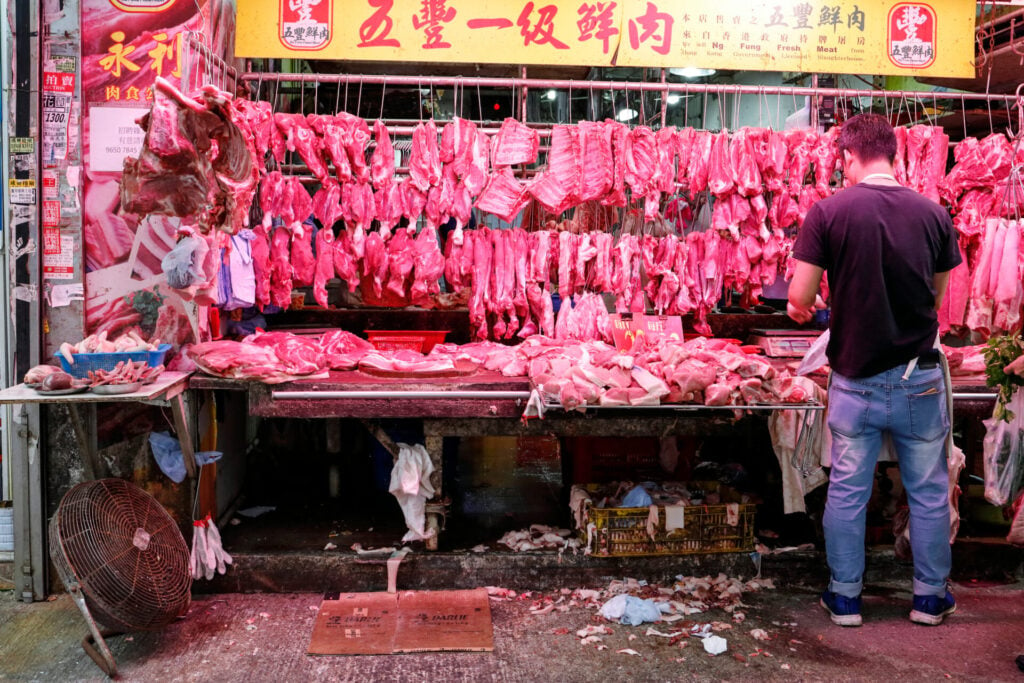
While many scientists back the theory that the coronavirus began in bats, the infected animal that transmitted it to a human remains a mystery. What remains certain is that markets like Wuhan’s play host to thousands of people and caged animals – both wild and domesticated – which wouldn’t normally cohabit the same space.
Huahan Market was misleadingly called a wet market, saddling these safe and legal trading places with the words ‘global pandemic’ forever. Found across the world from Sweden to Sydney, wet markets literally take their name from their hosed-down floors and melting ice which keeps food such as fish, fresh. Millions of people depend on them daily to buy food at affordable prices. A lifeline for communities, wet markets are also an important source of livelihood and culturally significant.
Huahan Market was misleadingly called a wet market, saddling these safe and legal trading places with the words ‘global pandemic’ forever. Found across the world from Sweden to Sydney, wet markets literally take their name from their hosed-down floors and melting ice which keeps food such as fish, fresh.
Markets like Huanan are, in fact, wildlife markets, which, as well as selling and slaughtering live animals on site, peddle non-domesticated wild species both dead and alive, making them a channel for the legal and illegal trade in animals. Researchers at Princeton University have called for better classification of wet markets, so that they are clearly distinguishable from their wildlife market cousins, which pose a threat to global public health as well as biodiversity.
Caged and Afraid
Wildlife captured and sold in wildlife markets are typically confined to cramped and filthy cages that are cesspools of disease and despair. Panicked, dehydrated, hungry and often injured, the animals suffer unimaginable cruelty while awaiting their fate. ‘They experience high levels of stress due to overcrowding and unhygienic conditions which weakens their immune system making them more susceptible to infections,’ Ubale says. Wild species are even more vulnerable to shedding dangerous viruses as they’re not used to being in captivity.
‘These cages are often stacked on top of each other leaving animals at the bottom exposed to urine, faeces and other waste from the animals above. They are stressed from the loud noises and witnessing the slaughter of other animals.’
Amruta Ubale, Executive Director Animal Equality
Undercover investigations by People for the Ethical Treatment of Animals (PETA) reveal horrifying realities. In Bangkok’s Khlong Toei Market, PETA uncovered bags of live frogs squashed up against the bodies of slaughtered ones. Meanwhile, chickens with open wounds bound to other birds, faeces-encrusted cages and caracal cats – a medium lynx-like wild cat – with no space to turn around, remain common sightings across Asia’s wildlife markets.
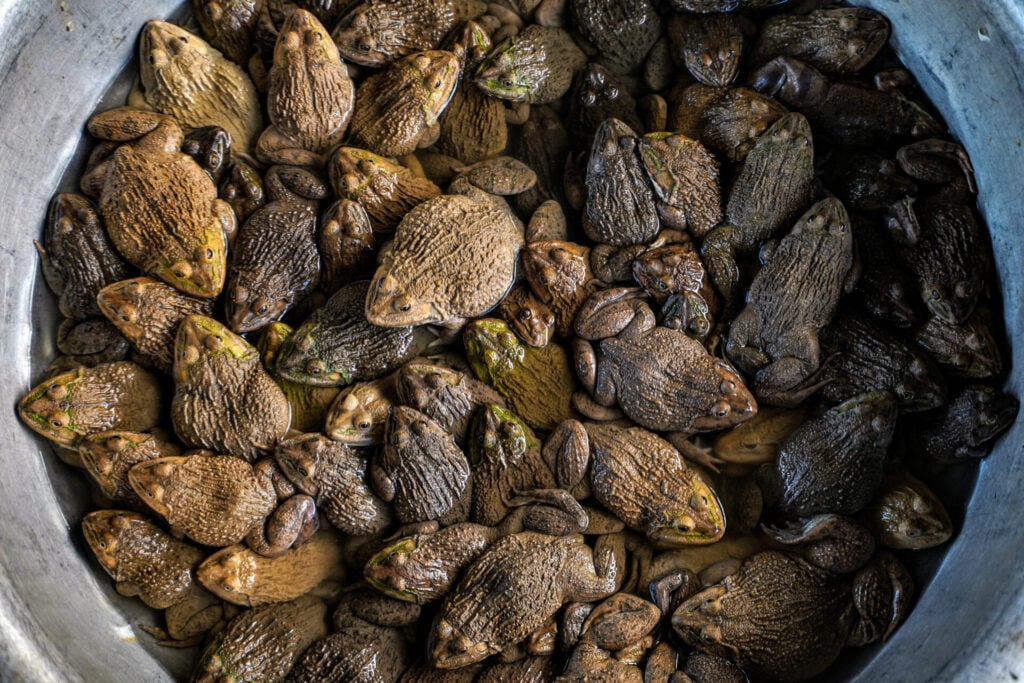
More than 2,500 miles away in India, animals destined for wildlife markets are made to travel for hours crammed in small cages without food or water. Ubale says: ‘These cages are often stacked on top of each other leaving animals at the bottom exposed to urine, faeces and other waste from the animals above. They are stressed from the loud noises and witnessing the slaughter of other animals.’
On the idyllic Indonesian island of Bali, so-called bird markets have been found to peddle flightless creatures, too. PETA exposed a trader selling primates including a slow loris – a protected species that’s critically endangered in Indonesia – ‘off the books’ in Bali’s Satria bird market in 2023, with the same shop reportedly selling monkeys the previous year. The sale of high-risk species like pangolin and turtle for traditional medicine, human consumption and luxury products doesn’t just happen behind closed doors. Wildlife markets are also fuelling the illegal capture and trade in exotic animals – which is valued at $73 bn (AED 268 bn) annually, pushing already endangered species closer to the edge of extinction.
Justice for Dogs
It’s not only wild animals but pets that are subjected to unimaginable cruelty in the wildlife markets of Indonesia’s North Sulawesi Province. One of the most brutal and bloody is Tomohon which has been in business for over a century. Here, rats, bats and pythons are butchered alongside live animals. Aside from the public health risks, Tomohon practices extreme animal brutality, though the sale of cat and dog meat was outlawed as part of an historic agreement made in July 2023 between traders and animal welfare campaigners, ending decades of animal mistreatment to man’s best friend, who were bludgeoned and blow-torched alive in the market.
‘With over 200 markets selling dogs and cats for meat in North Sulawesi alone, the scale of the problem is potentially catastrophic for Indonesia’s attempts to eliminate rabies’
Lola Webber, Co-founder of Change For Animals Foundation
Ninety per cent of Northern Sulawesi’s dogs on sale are believed to be stolen pets. The fact that this province has one of the highest numbers of human deaths from rabies in the country is no coincidence. There’s a proven link between the dog meat trade and the transmission of deadly rabies that’s sadly endemic in 25 out of 34 of Indonesia’s provinces. Co-founder of Change For Animals Foundation, Lola Webber, says: ‘With over 200 wildlife markets selling dogs and cats for meat in North Sulawesi alone, the scale of the problem is potentially catastrophic for Indonesia’s attempts to eliminate rabies.’
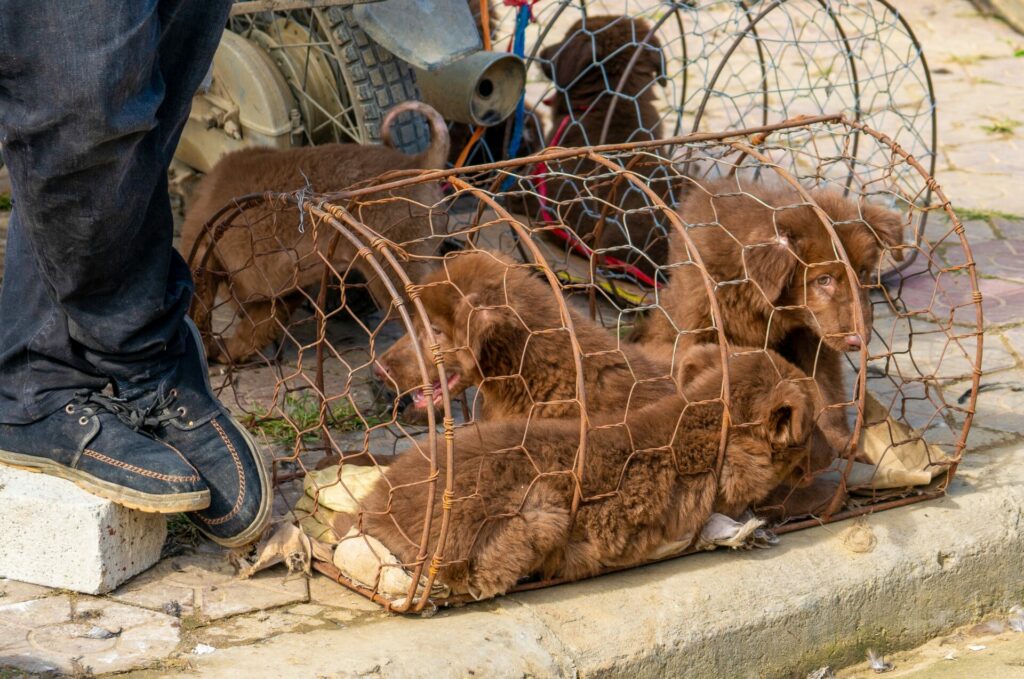
One of the biggest challenges is shifting attitudes towards traditional medicine with some Sulawesi natives believing that dog leg soup cures dengue fever – a sometimes fatal mosquito-borne illness – in children. Locals also have an appetite for bats, one of the highest-risk species for emerging infectious diseases.
A study published by Harvard University reported that more than a million bats are sold in Sulawesi markets each year, served skewered or in a coconut milk curry. Vulnerable Flying foxes, a type of megabat, are considered a delicacy, too.
Bird Flu and ‘The Big Apple’
Asia’s live bird markets are hotbeds for harmful pathogens particularly when, unsurprisingly, it comes to bird flu. Research published by scientific journal Nature Communications found that one in ten birds arriving at live bird markets are already exposed to a zoonotic strain of the avian influenza virus known as H9N2. The speed at which it can spread is terrifying, with nine out of ten healthy chickens entering a live bird market becoming infected within 24-hours. The takeaway from the study was that pandemic prevention strategies must be rolled-out before poultry even enters a wildlife market.
There’s little doubt that wildlife markets pose a risk to both human health and biodiversity at large. But the misplaced fear around all wet markets speaks more about the western world’s disconnection with the source of our food than anything else
The cruel caging of birds doesn’t only happen in Asia. Better known for its iconic skyline, New York has the largest number of live bird markets in America according to Humane Society International (HSI). In 2022 and 2023, avian flu was found in several of NYC’s state-licensed live animal markets.
Sadly, the story doesn’t end there. Spread across five boroughs are storefront slaughterhouses, where penned animals including ducks, guinea fowl, rabbits, cows, goats and sheep are killed on site at the request of paying customers. A visit to one in January 2024 by Bob Holden left the New York lawmaker appalled. ‘The conditions are barbaric,’ he said. ‘All the animals are packed in. We saw birds with open sores and we saw sick and dead birds in the cages.’
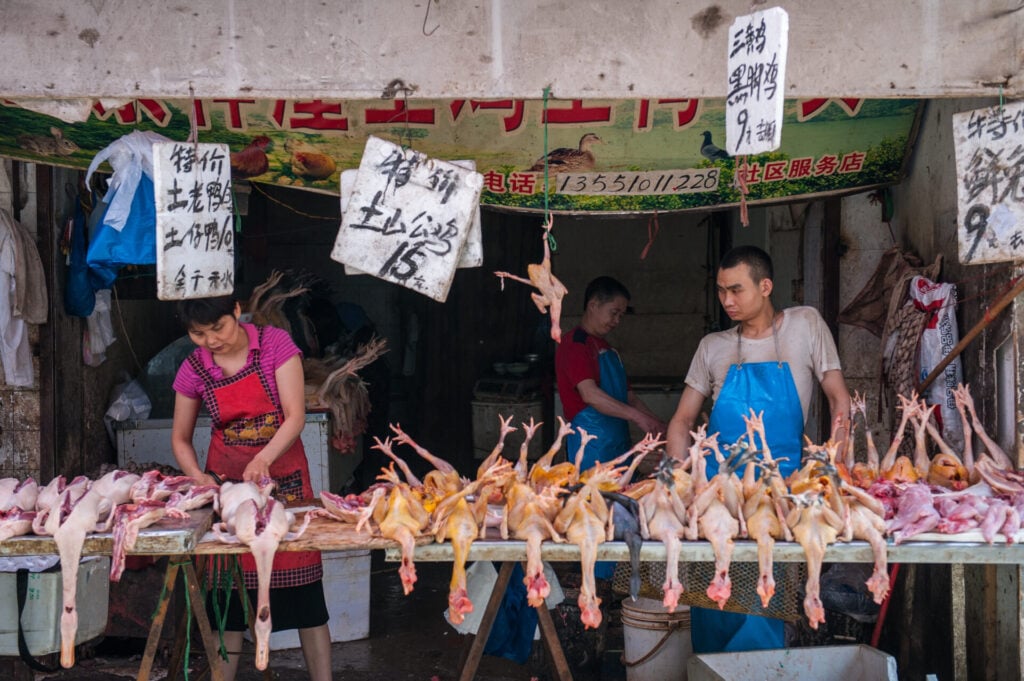
There’s little doubt that wildlife markets pose a risk to both human health and biodiversity at large. But the misplaced fear around all wet markets speaks more about the western world’s disconnection with the source of our food than anything else. So, what is the solution to preventing the next global pandemic?
Stopping deadly viruses jumping from animals-to-humans in the first place is key. But breaking the chain of disease transmission is no easy task, with deforestation, intensive farming and urbanisation driving humans closer to wildlife than ever before. By reducing our encroachment on wildlife habitats, better regulating the trade of exotic animals and shuttering wildlife markets, we may just have a fighting chance.
Whilst there isn’t a silver bullet for easily averting another world health emergency, there’s no question that taking care of our planet and the animal kingdom is a very good place to start.



